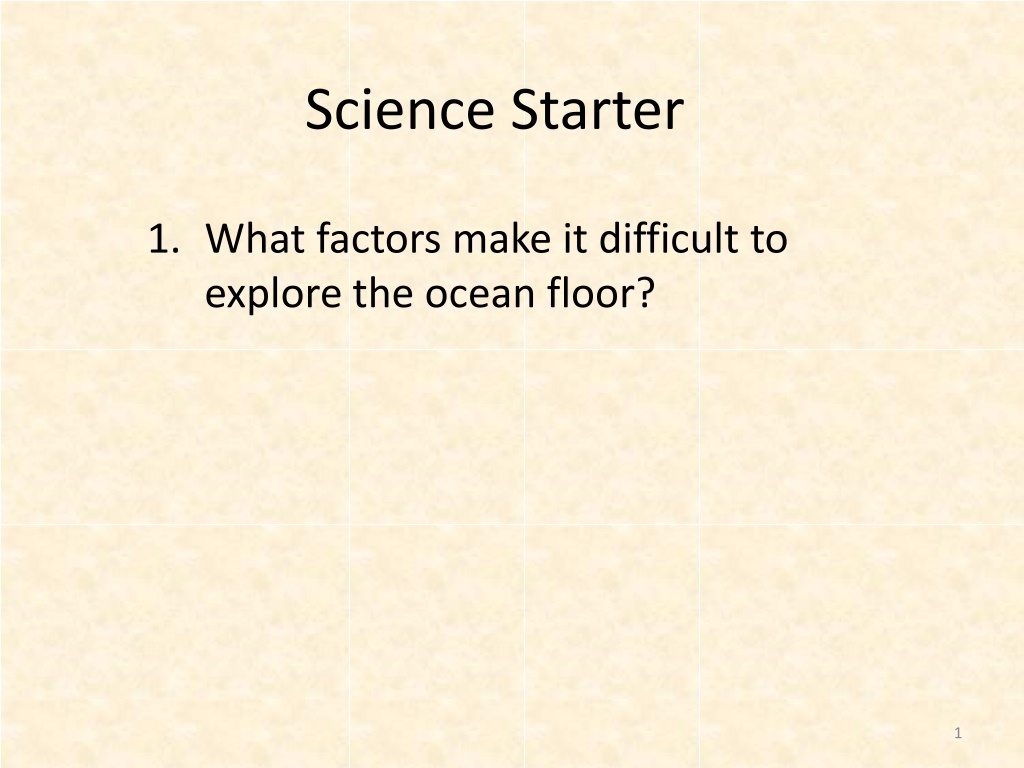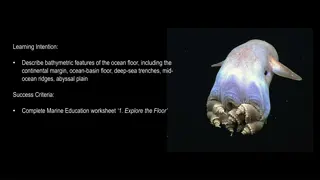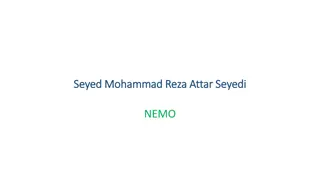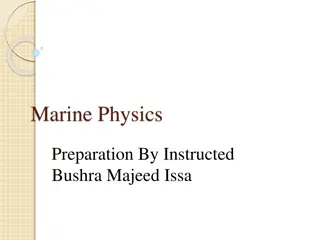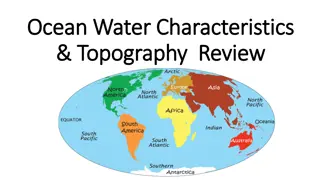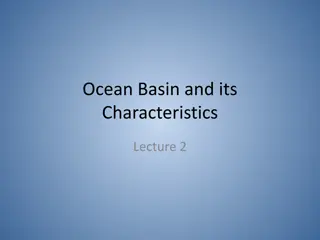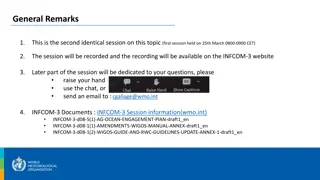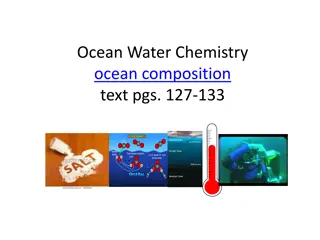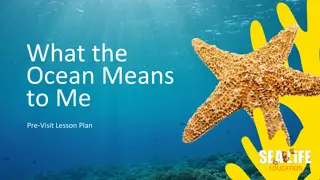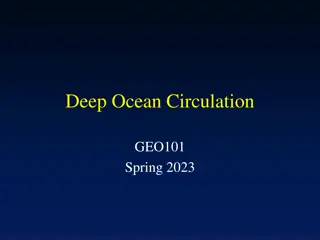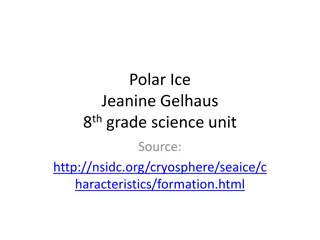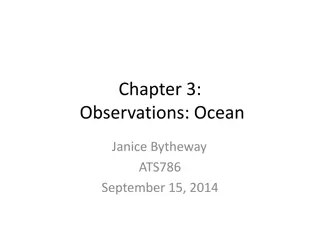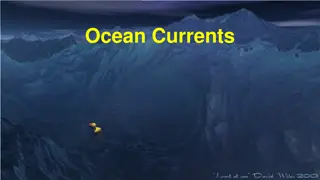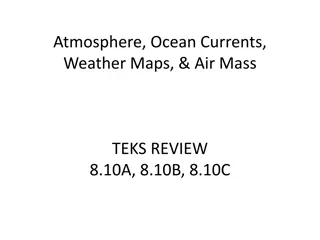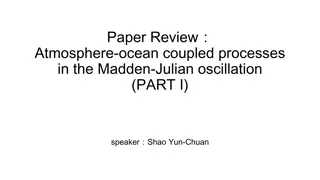Exploring the Ocean Floor: Challenges and Discoveries
Studying the ocean floor presents challenges due to its depth, darkness, cold temperatures, and high pressure. Sonar technology has helped in exploration, revealing diverse features like mountain ranges, canyons, and plains. The ocean is divided into zones with distinct ecosystems, showcasing the vast diversity of marine life.
Download Presentation

Please find below an Image/Link to download the presentation.
The content on the website is provided AS IS for your information and personal use only. It may not be sold, licensed, or shared on other websites without obtaining consent from the author. Download presentation by click this link. If you encounter any issues during the download, it is possible that the publisher has removed the file from their server.
E N D
Presentation Transcript
Science Starter 1. What factors make it difficult to explore the ocean floor? 1
Georgia Performance Standards c. Describe the composition, location, and subsurface topography of the world s oceans. d. Explain the causes of waves, currents, and tides. 3
The Ocean Floor Why is studying the ocean floor difficult? Studying the ocean floor is difficult because the ocean is so deep. The deep ocean is dark, and the water is very cold. The pressure is very high in the deep ocean. What technology is used to study the ocean floor? Studying the ocean floor got easier when sonar was invented. Sonar stands for Sound navigation and ranging. Sonar is a system that uses sound waves to find the distance to an object. Minisub called Alvin Underwater airplane- Deep Flight Sum it up: The ocean floor is difficult to study because it is very deep, the water is very cold and the pressure is too great. 4
The Ocean Floor Traveling along the ocean floor, you could expect to see an area of mountain ranges, deep canyons, and many other features. If you could travel along the ocean floor, what would you expect to see? You would see the continental shelf which is a gently sloping, shallow area at the edge of a continent. The continental slope is the steep dropoff at the far edge of the continental shelf. On the ocean floor, there are both flat areas and mountains. The abyssal plain is a smooth, nearly flat region of the ocean floor. The mid-ocean Ridge is a very long mountain range that winds around Earth. The mid-ocean ridge passes through all of Earth s oceans. A trench is a deep canyon in the ocean floor. Sum it up: The ocean floor is not a flat, sandy area. It has mountain ranges, deep canyons, and many other features. 5
Ocean Zones The ocean is divided into three zones. How is the ocean divided? 1. The intertidal zone stretches from the line made by the highest tide on shore to the line on the continental shelf where the lowest low tide ends. 2. The neritic zone goes from the low-tide line to the edge of the continental shelf. 3. The open-ocean zone is the vast area beyond the edge of the continental shelf. Sum it up: Each of the three ocean zones has its own physical conditions. The physical conditions of a zone determine what kinds of organisms live in that zone. 6
Earths Oceans Arctic Ocean 1. Smallest ocean and much of it is covered by ice. B. Indian Ocean 1. Third largest ocean 2. Mid-ocean ridge runs along the Indian Ocean Floor. C. Pacific Ocean 1. The largest ocean 2. Has enough water to fill 1.2 trillion bathtubs D. Atlantic Ocean 1. Half of the Pacific Ocean How are the global oceans divided? A. How much of the Earth surface is covered with water? of Earth surface is covered with water. 7
Characteristics of Ocean Water 1. Ocean water is not safe to drink. 2. Ocean water is salty. a. sodium chloride- NaCl (compound) b. salt is the most dissolved solid in the ocean 3. Chock- full of solids a. If more water evaporates than enters the ocean, the oceans salinity increases. b. Salinity the measure of the amount of dissolved salts and other solids in a given amount of liquid. 4. Factors That Affect Salinity a. Some area of the ocean are saltier than others b. Hot and dry climates have higher salinity than cooler more humid areas c. water movement 5. Temperature zones a. The temperature of the water decreases as the depth of the water increases. What are the characteristics of ocean water? 8
Life In The Ocean 1. Plankton- a. organisms that float at or near the ocean s surface b. Most plankton are microscopic c. Divided into two groups: plantlike (phytoplankton) and animal like (zooplankton) 2. Nekton a. free-swimming organisms of the ocean b. Most abundant in surface water c. Mammals: whales, dolphins, sea lions and other fish 3. Benthos a. Organisms that live on or in the ocean floor b. They live in mud, sand, and rock c. Examples: crabs, sea stars, worms, coral, sponges, etc. What are the 3 groups of marine life? 9
Ocean Environment I. Benthic Environment- Ecological Zones A. Intertidal Zone- 1. Shallowest zone and is located between high tide and low tide. 2. Organisms must be able to live in both underwater and on exposed land. (crabs) B. Sublittoral Zone- 1. Begins where the intertidal zone ends at the low tide limit. 2. Extends to the edge of the continental shelf. 3. Temperature, sunlight and water pressure remains constant What are the environment of the ocean? 10
C. Bathyal Zone- 1. Extends from the edge of the continental shelf to the abyssal plain 2. Very little sunlight and scare plant life 3. Sponges, brachiopods, sea stars, octopuses D. Abyssal Zone- 1. No plants and very few animals 2. Scientists know very little about this zone because it is so dark and deep 3. Sponges, worms, and sea cucumbers E. Hadal Zone- 1. The deepest benthic zone 2. Ocean floor trenches 3. A few species of worms and clams 11
The Pelagic Environment A. Neritic Zone 1. Includes the volume of water that covers the continental shelf. 2. Warm and shallow water, which contains the largest amount of marine life 3. Gets lots of sunlight 4. Fish, plankton and marine mammals B. Oceanic Zone- 1. Water temperature is colder and the pressure is much greater than the neritic zone. 2. Organisms are more spread out 3. Great giant squids and whales What does the pelagic environment consist of? 12
Wave Action A water wave is the movement of energy through a body of water. The size of a wave depends on two factors: 1. the strength of the wind 2. the length of time the wind blows Waves do not actually carry water forward. The energy of a wave moves toward a shore, but the water itself stays in place. As a wave passes a place, water particles move in a circle. The particles move forward and down with the energy of the wave and then back to their original positions. The highest part of a wave is called the crest. A wavelength is the distance from one crest to the next crest. Waves are also measured by their frequency. Frequency is the number of waves that pass a point in a certain amount of time. The lowest part of a wave is called the trough. Waveheight is the up-and-down distance from a crest to a trough. What is a wave? 13
A tsunami is a wave that forms far below the ocean surface. Earthquakes under the ocean floor cause tsunamis. When a tsunami reaches a coast, it can destroy buildings and bridges. A tsunami in deep water may have a long wavelength but a small wave height. When the tsunami reaches shallow water near a coast, the wave height increases as the water piles up. The tsunami becomes a towering wall of water. 14
Tides What causes tides? Tides are the daily rise and fall of Earth s waters on its coastlines. As a tide comes in, the level of water rises. High tide is when the water is highest. Then the tide flows out, flowing back toward the sea. Low tide is when the water reaches its lowest point. Gravity causes tides. Gravity is the force an object has that pulls other objects toward it. The moon s gravity pulls on Earth s waters. The moon s gravity creates a bulge of water on the side of Earth closest to the moon. The water on the other side of Earth forms a second bulge. These are called tidal bulges. In places where there are tidal bulges, high tide occurs. In many places, there are two high tides and two low tides each day. In other places, one set of tides is so small that it seems like there is only one high tide and one low tide per day. 15
Tides The sun s gravity also affects Earth s tides. The sun pulls the water on Earth s surface toward it. When the sun and the moon are lined up, their gravities combine to produce a spring tide. A spring tide is a tide with the greatest difference between high tide and low tide. When the sun and the moon are at right angles to each other, the sun s gravity pulls some water away from tidal bulges. The result is a neap tide. A neap tide is a tide with the least difference between high tide and low tide. 16
Energy From Tides The movement of huge amounts of water between high and low tide is a source of potential energy energy that is stored and can be used. A lot of water moves between high and low tides. In some places, tidal power plants use the energy of tides to produce electricity. The energy of tides is used only in places where there is a big difference between high tide and low tide. There are very few places in the world with such a big difference. 17
